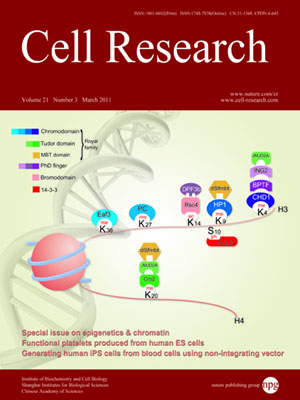
Volume 21, No 3, Mar 2011
ISSN: 1001-0602
EISSN: 1748-7838 2018
impact factor 17.848*
(Clarivate Analytics, 2019)
Volume 21 Issue 3, March 2011: 502-517
REVIEWS
Cancer epigenetics: linking basic biology to clinical medicine
Hsing-Chen Tsai and Stephen B Baylin
The Sidney Kimmel Comprehensive Cancer Center at Johns Hopkins, The Bunting-Blaustein Cancer Research Building, Suite 541, 1650 Orleans Street, Baltimore, MD 21231, USA
Correspondence: Stephen B Baylin,(sbaylin@jhmi.edu)
Cancer evolution at all stages is driven by both epigenetic abnormalities as well as genetic alterations. Dysregulation of epigenetic control events may lead to abnormal patterns of DNA methylation and chromatin configurations, both of which are critical contributors to the pathogenesis of cancer. These epigenetic abnormalities are set and maintained by multiple protein complexes and the interplay between their individual components including DNA methylation machinery, histone modifiers, particularly, polycomb (PcG) proteins, and chromatin remodeling proteins. Recent advances in genome-wide technology have revealed that the involvement of these dysregulated epigenetic components appears to be extensive. Moreover, there is a growing connection between epigenetic abnormalities in cancer and concepts concerning stem-like cell subpopulations as a driving force for cancer. Emerging data suggest that aspects of the epigenetic landscape inherent to normal embryonic and adult stem/progenitor cells may help foster, under the stress of chronic inflammation or accumulating reactive oxygen species, evolution of malignant subpopulations. Finally, understanding molecular mechanisms involved in initiation and maintenance of epigenetic abnormalities in all types of cancer has great potential for translational purposes. This is already evident for epigenetic biomarker development, and for pharmacological targeting aimed at reversing cancer-specific epigenetic alterations.
Cell Research (2011) 21:502-517. doi:10.1038/cr.2011.24; published online 15 February 2011
FULL TEXT | PDF
Browse 2167


